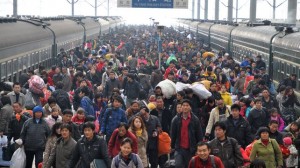Migration in the media: the last word
 Newspapers and media play a critical role in framing the discourse on immigration, according to a new report from the UK.
Newspapers and media play a critical role in framing the discourse on immigration, according to a new report from the UK.
Descriptive words and language used around terms such as ‘migrants’, ‘refugees’ or ‘asylum seekers’ can colour attitudes and influence public perceptions and thinking, research by The Migration Observatory at the University of Oxford suggests.
The research revealed a picture of a pejorative or preconceived approach to migrants and refugees by the media – borne out in the descriptive terms used.
The most common descriptor for the word ‘immigrants’ was the word ‘illegal’ used in about eight per cent of stories.
A focus on numbers of immigrants was also revealed in the research with words like ‘millions’ and ‘thousands’ appearing across all newspaper types.
The researchers embarked on a ‘big data’ quantitative analysis of the language used by all twenty of Britain’s main national daily and Sunday newspapers.
The study covered all news stories, letters and other published content dealing with migrants and migration over three years between 2010 to the end of 2012 and involved analysis of 58,000 news stories and other newspaper items made up of 43 million words from stories which include key terms such as ‘migrants’, ‘immigrants’, ‘refugees’, ‘asylum seekers’ or variations of those words.
The researchers broke the newspaper types down into three groups: broadsheets, mid-market papers and tabloids.
They found tabloid newspapers more likely to use words which indicate concerns around security or legality such as ‘terrorist’, ‘suspected’ and ‘sham’ when referring to immigrants. The tabloids were also more likely to include words referring to movement such as ‘into’, ‘stay’ and ‘stop’.
“Words suggesting water as a metaphor for migration, such as ‘flood’, ‘influx’ and ‘wave’ are also commonly used by all types of newspapers in reference to both ‘migrants’ and ‘immigrants’, the report said.
“‘Failed’ is the most common descriptor for ‘asylum seekers’ across all newspaper types. ‘Illegal’ is also a descriptor in both mid-market and broadsheet newspapers. Other descriptors in broadsheets suggest vulnerability – such as ‘child’, ‘destitute’ and ‘vulnerable’,” it said.
“Some commonly used references for ‘asylum seekers’ in midmarket newspapers focused on illegality and permanence, including ‘illegal’, ‘criminals’ and ‘stay’. Broadsheets also consistently used ‘illegal’ and ‘criminals’, albeit at a lower frequency and among a larger set of references.
“Language around ‘refugees’ was strikingly different to other target words. References relating to ‘refugees’ focused on conflict and fleeing and on refugees’ nationalities. Broadsheets had considerably more descriptors and consistent references for ‘refugees’ than mid-market or tabloid newspapers,” the report said.
The researchers said that the study was not aimed at arriving at conclusions on media attitudes towards migration.
“Developing a clearer understanding of the language that these newspapers use to discuss migrants and migration can… provide us with important insights into the nature of this debate and the role of newspapers in it,” they said.
“The report is, however, intended to provide both useful insights into the language used and the ways that different types of newspapers approach the subject of immigration, and to provide a bed of evidence for further social science investigations into the subject of migration in the media,” they said












